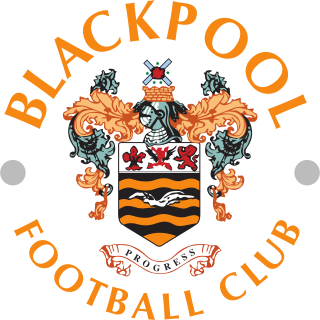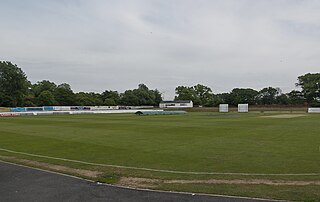
Blackpool Football Club is a professional association football club based in the seaside town of Blackpool, Lancashire, England. The team competes in the Championship, the second tier of the English football league system.

Bloomfield Road is a single-tier football stadium in Blackpool, Lancashire, England, which has been the home of Blackpool F.C. since 1901. It is the third stadium in the club's existence, the previous two being Raikes Hall Gardens and the Athletic Grounds.

Blackpool Borough was a rugby league club based in Blackpool, Lancashire, England, that played in the Rugby Football League from 1954 until 1993. The club moved to Wigan in 1987 and was renamed Springfield Borough; to Chorley in 1988 and was renamed Chorley Borough; to Altrincham in 1989 and was renamed Trafford Borough, and finally back to Blackpool in 1992 as Blackpool Gladiators. It folded in 1997.
Thames Ironworks Football Club, the club that later became West Ham United, was founded by Thames Ironworks and Shipbuilding Co. Ltd owner Arnold Hills and foreman Dave Taylor in 1895. Thames Ironworks took over the tenancy of The Old Castle Swifts' Hermit Road ground in Canning Town until their eventual eviction in October 1896. They would briefly play at Browning Road in East Ham, before moving to the Memorial Grounds, a stadium which was situated close to where West Ham station now stands. The ground was built at Arnold Hills's own expense, costing £20,000.
Memorial Grounds was the home stadium of East London football club Thames Ironworks from the beginning of the 1897–98 season, until the end of the 1899–1900 season. The team continued to play at the stadium, under its new name of West Ham United, until they moved to the Boleyn Ground in 1904. The Memorial Grounds stadium was situated at the east end of Memorial Avenue, West Ham, close to where West Ham station now stands.
George Horsley "Geordie" Anderson was a Scottish professional footballer. He played as a defender and, later, as a forward.
Robert Kirkham Birket was an English professional footballer who spent his entire ten-year Football League career with Blackpool after signing from Fleetwood Rangers.
Linthorpe Road was a cricket and football ground in Middlesbrough in England. It was the home ground of Middlesbrough Cricket Club and Middlesbrough F.C.

The history of Blackpool Football Club between 1887 and 1962 covers the years from the club's foundation, via a split from another Blackpool-based club; the period of nine years before they gained membership to the Football League; their recovery after losing their League status after only three seasons; and finally their rise into Division One, which was then the top tier of English football. Aside from the League, Blackpool also appeared in three FA Cup Finals in six years, finding success in their third attempt, in 1953. The same year, the club supplied the England team with four players for an international game against Hungary.

Blackpool Cricket Club is a cricket club based in Stanley Park, in Blackpool, Lancashire. Located in western quadrant of the park, the club plays at a 5,000-seater ground, which is regularly used for county cricket matches by Lancashire.

South Shore Football Club was an English football club based in the South Shore area of Blackpool.
The 2010–11 season was Blackpool F.C.'s debut season in the Premier League, after winning the 2009–10 Championship play-off Final in what was their 99th consecutive season in the Football League. It was also their 28th overall season in English football's top tier, but their first since 1971. It was Ian Holloway's second season as manager. The club finished 19th and were relegated back to the Championship.
Abbey Park was a football stadium in Grimsby, Lincolnshire, England. It was the home ground of Grimsby Town between 1889 and 1899.
The Alexandra Recreation Ground, also known as Nantwich Road, was a multi-sport venue in Crewe in England. It was the home ground of Crewe Alexandra, and also hosted an FA Cup semi-final and the 1886-87 Welsh Cup final, both in 1887, and an England home match in 1888.
Barley Bank was a cricket and football ground in Darwen in England. It was the home ground of Darwen F.C. during their time in the Football League.
The Athletic Grounds was a sports ground in Blackpool, England. It was the home ground of Blackpool F.C. between 1897 and 1898, and it was the 55th ground to host a Football League game.
Wellington Road was a football ground in the Perry Barr area of Birmingham, England. It was the home ground of Aston Villa from 1876 until 1897.

Dunstable Road, also known as Bury Park, was a football ground in Luton, England. It was the home ground of Luton Town between 1897 and 1905.
New Logie Green was a football ground in the Powderhall area of Edinburgh, Scotland. It was the home ground of St Bernard's from 1889 until 1899, and was also used to host the 1896 Scottish Cup final, the only time the Scottish Cup final has been played outside Glasgow. The ground was named after a nearby mansion.
Hawkhill was a cricket and football ground in the Leith area of Edinburgh, Scotland. It was the home ground of Leith Athletic.







